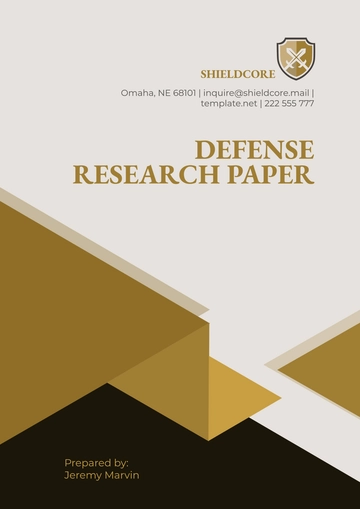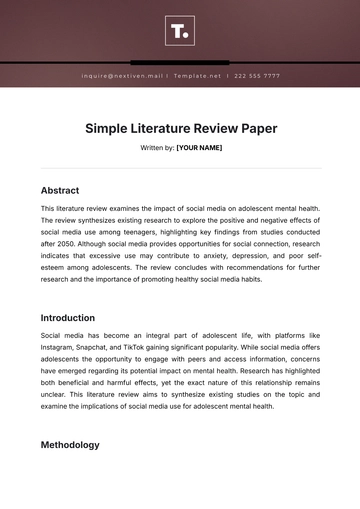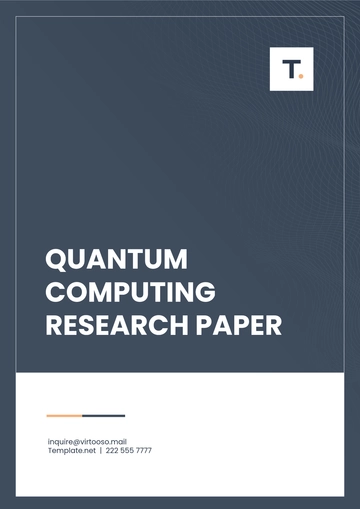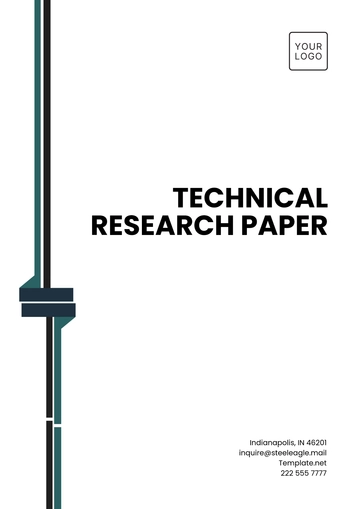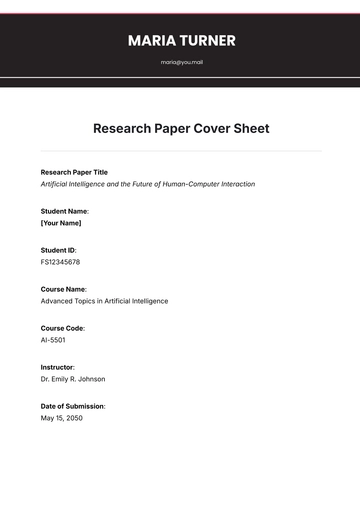Free Defense Research Paper
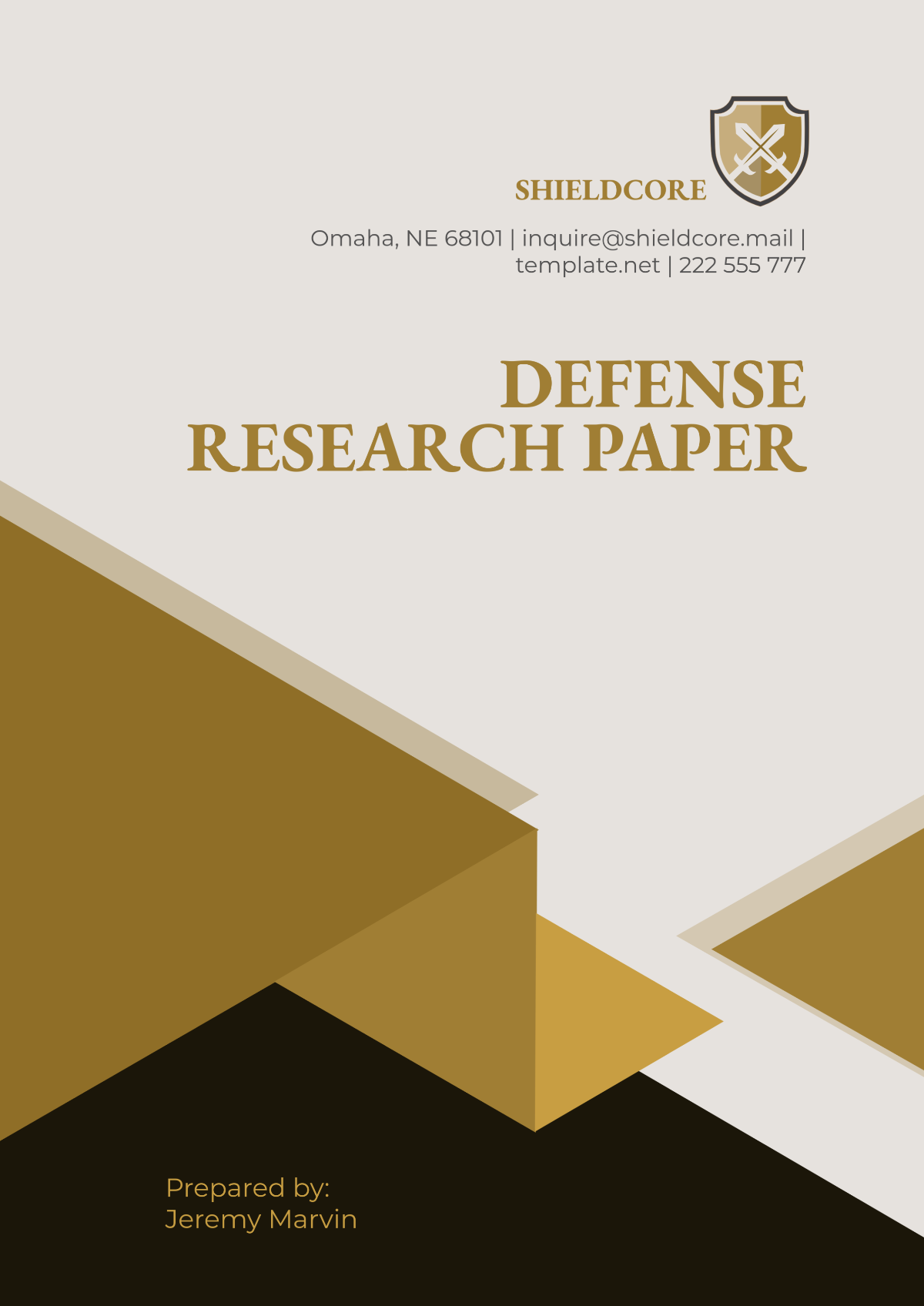
I. Introduction
A. Background of Defense Technology
Defense technology has long been a critical factor in ensuring national security, protecting borders, and securing global peace. The development of these technologies has been pivotal in shaping geopolitical relations and providing military superiority. From the advent of nuclear technology to the use of advanced robotics and cyber defense systems, the evolution of military technology has mirrored the increasing complexity of warfare. By 2050, the defense industry has achieved extraordinary advancements in artificial intelligence, quantum computing, and autonomous systems, transforming military strategies, operations, and logistics. While these technologies offer enhanced capabilities, they also introduce new risks and ethical dilemmas that must be addressed to prevent misuse and promote global stability.
B. Objectives of the Research
This research paper aims to:
Analyze the Current Trends in Defense Technology: Examining the cutting-edge technologies currently being deployed and developed by military forces across the globe.
Identify the Challenges Faced by Defense Organizations: Exploring the hurdles that military and defense contractors face as they push the boundaries of innovation.
Propose Recommendations for Sustainable and Ethical Defense Innovations: Providing actionable insights for the continued development and responsible deployment of defense technologies.
The focus will be on defense systems that address both conventional and non-conventional threats, ranging from traditional combat systems to cybersecurity and AI-powered defense systems.
II. Emerging Trends in Defense Technology
A. Artificial Intelligence (AI) in Defense
Artificial Intelligence (AI) has become an integral part of modern defense strategies, providing unprecedented capabilities in decision-making and operational management. AI systems are deployed across various platforms, including unmanned aerial vehicles (UAVs), autonomous ground systems, and cyber defense networks. These technologies not only enhance combat readiness but also enable real-time analysis of vast datasets to predict future threats.
Predictive Maintenance Systems: One of the key applications of AI in defense is predictive maintenance, which analyzes equipment usage data to forecast failures before they occur. By 2050, predictive AI-driven maintenance systems have helped reduce equipment downtime by [30%] in many defense operations, significantly cutting costs related to repairs and replacements.
Autonomous Vehicles: AI-powered autonomous vehicles, including drones and tanks, are increasingly used to conduct high-risk missions without exposing human soldiers to danger. These vehicles can execute complex maneuvers in combat zones, assess environmental conditions, and adapt to real-time threats with little to no human oversight. Their deployment allows for highly strategic operations, reducing human casualties while maintaining operational effectiveness.
The introduction of AI also enables autonomous decision-making, where AI systems can analyze battlefield scenarios and recommend tactical actions. This reduces response time in critical situations, enhancing mission success rates.
B. Quantum Computing
Quantum computing represents a leap forward in computational power, which has profound implications for both cryptography and defense technology. Quantum computers use the principles of quantum mechanics to perform calculations at speeds unimaginable for classical computers. By 2050, quantum computing has significantly altered the landscape of defense, particularly in areas requiring rapid processing of massive datasets and advanced encryption techniques.
Encryption and Decryption: Quantum computers can break current encryption standards within seconds, making them both a potential threat and a tool for improving national security. Governments and defense agencies are investing heavily in quantum-resistant encryption methods to safeguard communications and military data.
Optimization Problems: Quantum computing has also been used to solve complex optimization problems, such as logistical planning for troop deployments, resource distribution, and the analysis of combat scenarios. Quantum algorithms can find optimal solutions to these problems in a fraction of the time it would take traditional systems, offering a strategic advantage in military operations.
In future conflicts, the ability to deploy quantum-secured communications systems will be a critical component of cyber defense, ensuring the protection of sensitive military data.
C. Directed Energy Weapons (DEWs)
Directed Energy Weapons (DEWs) have become an increasingly popular alternative to conventional projectile-based weapons. DEWs use concentrated energy, such as lasers or microwaves, to disable or destroy targets with pinpoint accuracy. The main advantages of DEWs include their high precision, low cost per shot, and the ability to engage multiple targets in rapid succession.
Precision Targeting: DEWs, particularly high-energy lasers, are capable of disabling enemy systems with unmatched precision. These systems are particularly effective against drones, missiles, and small boats, which are often difficult to target with traditional weapons.
Cost-Efficiency: One of the most significant advantages of DEWs is their cost-effectiveness. The cost per shot for a directed energy weapon is a fraction of the cost of a conventional missile or bomb. For instance, each shot of a high-energy laser costs as little as [$5], compared to a missile that can cost upwards of [$100,000] per launch.
Moreover, DEWs are virtually limitless in terms of ammunition, as they rely on electrical power rather than physical projectiles, providing sustained firepower in long-term engagements.
III. Challenges in Defense Technology
A. Cybersecurity Threats
The integration of digital technologies into defense systems has expanded the attack surface for adversaries. Cybersecurity threats are among the most significant risks facing modern defense infrastructure. By 2050, military systems are increasingly reliant on complex networks, AI, and data-sharing platforms, all of which are susceptible to cyber-attacks. These attacks can disrupt military operations, steal sensitive information, or cause irreversible damage to critical infrastructure.
Cyber Breaches and Financial Losses: A report from 2050 reveals that [85%] of global defense systems have experienced at least one major cyber intrusion. These breaches have led to financial losses exceeding [$10 billion] annually due to the theft of sensitive data, disruption of operations, and the costs of responding to and recovering from such attacks.
Adversarial Cyber Warfare: Nation-state actors are increasingly employing cyber-attacks as part of hybrid warfare tactics. These attacks, which may involve disabling power grids, hacking into military command systems, or spreading disinformation, pose a major challenge to national defense agencies. The integration of AI in cyber defense has been crucial in developing real-time threat detection systems to counter these attacks.
The increasing sophistication of cyber weapons means that defense organizations must stay ahead of cybercriminals and hostile nations to protect sensitive data and infrastructure.
B. Ethical and Legal Concerns
As defense technologies evolve, so do the ethical and legal challenges associated with their use. The deployment of autonomous weapons, AI-driven decision-making systems, and AI in surveillance has raised significant concerns about accountability and the potential for misuse.
Accountability for Autonomous Systems: One of the key ethical concerns is accountability in the use of autonomous systems. For example, AI-powered drones and robots may make decisions based on algorithmic predictions, but who is responsible if they cause unintended harm? Is it the developer of the AI, the military commander, or the government that deployed the system?
Ethical Dilemmas in Warfare: Autonomous weapons may be capable of conducting military operations with minimal human intervention, but they lack the moral judgment required to make life-and-death decisions. The potential for machines to make autonomous decisions about targeting and the use of lethal force presents significant ethical concerns that must be addressed by policymakers, ethicists, and military leaders.
International agreements may be necessary to regulate the use of autonomous weapons and AI systems to ensure that they are used in compliance with international humanitarian law and to prevent violations of human rights.
C. Environmental Impacts
The environmental impact of military activities and defense technology has come under increasing scrutiny in recent years. Military operations, manufacturing, and testing all contribute to carbon emissions, pollution, and habitat destruction.
Military Emissions and Resource Consumption: Defense-related activities are responsible for a substantial portion of global carbon emissions, with estimates indicating that [15%] of total emissions come from military activities. By 2050, many defense agencies are exploring alternatives to reduce their carbon footprints, such as transitioning to electric vehicles for base operations and using solar power for energy needs.
Land and Water Use: Military exercises, weapons testing, and the construction of defense infrastructure have led to significant land degradation. Over [20,000 square kilometers] of land globally is used for military training and testing, much of which has been contaminated by explosives, chemicals, and waste materials.
Sustainable practices in defense manufacturing and operations, such as using green technologies and recycling materials, are essential for reducing the negative environmental impacts associated with defense activities.
IV. Solutions and Recommendations
A. Strengthening Cybersecurity Measures
To combat the rising tide of cyber threats, defense organizations must adopt robust cybersecurity measures. Some strategies include:
Multi-layered Encryption Systems: Developing advanced encryption methods that safeguard sensitive communications and data is essential for maintaining security in the digital age. Quantum-resistant encryption algorithms will become a critical part of national defense systems.
AI-Driven Cyber Defense: Leveraging AI for real-time detection of cyber threats will help defend against increasingly sophisticated cyber-attacks. AI systems can learn from historical attacks and identify new, unknown threats faster than human analysts can.
Personnel Training and Awareness: Investing in training defense personnel to recognize phishing attacks, safeguard classified data, and respond swiftly to potential breaches will reduce the risk of successful cyber-attacks.
B. Ethical Regulations for Autonomous Weapons
In light of the growing reliance on autonomous systems, it is vital to establish international regulations that govern their use in warfare. Some proposed measures include:
Human Oversight: Ensuring that human operators retain control over the use of lethal force is essential. While autonomous systems can assist in decision-making, the final approval for launching attacks should rest with qualified human personnel.
International Code of Conduct: Developing a universal code of conduct for the deployment of AI-driven weaponry would set global standards for their ethical use. This could include guidelines on the distinction between combatants and civilians, the prohibition of indiscriminate attacks, and the need to minimize harm.
C. Promoting Green Defense Technology
In an era of climate change, defense organizations must prioritize sustainability. Some key actions include:
Renewable Energy Adoption: Transitioning to renewable energy sources, such as solar and wind power, will help reduce the carbon footprint of military bases and operations. Many defense agencies are already exploring solar panels and wind turbines for power generation.
Sustainable Weaponry: Developing eco-friendly materials and sustainable production methods for weapons will mitigate the environmental impacts of manufacturing. Additionally, efforts to recycle materials from outdated military hardware can reduce waste.
V. Case Studies: Innovations and Applications
A. Project Sentinel by [Your Company Name]
Project Sentinel, launched in 2050 by [Your Company Name], exemplifies the cutting-edge integration of Artificial Intelligence (AI) and Quantum Computing in modern defense systems. The project is a flagship initiative aimed at enhancing military defense capabilities and addressing the challenges posed by increasingly sophisticated threats. It highlights how collaboration between advanced technologies can create revolutionary solutions that push the boundaries of current defense strategies.
AI-based Missile Defense System: The core of Project Sentinel’s defense architecture is its AI-driven missile defense system. This system uses machine learning algorithms to detect, track, and intercept incoming missile threats. The AI model is trained on historical data from various missile launches, allowing it to predict trajectory and velocity with high precision. The system employs real-time decision-making, enabling it to engage targets with [95%] accuracy, significantly increasing the probability of successful interception compared to traditional systems. The system’s effectiveness has been proven in numerous simulated and real-world environments, making it one of the most reliable missile defense platforms available today.
The system works by continuously analyzing data from sensors, radar systems, and satellite feeds to detect missile launches. Upon identifying a potential threat, the system calculates the best possible interception point and adjusts the defense system's targeting mechanism in real-time. The integration of AI ensures that the defense system adapts to changes in the environment, such as wind speed, temperature, and terrain, which affect missile trajectories.
Quantum Encryption: Quantum encryption is another critical aspect of Project Sentinel. As traditional encryption methods are increasingly vulnerable to quantum computing threats, [Your Company Name] has implemented a quantum-resistant encryption protocol that ensures the security of military communications. This encryption system leverages quantum key distribution (QKD) to generate secure cryptographic keys that are virtually impossible to hack using current and future computing methods.
The technology ensures that even if an adversary has access to a quantum computer, it will be unable to decrypt classified communications. This is achieved by exploiting the principles of quantum mechanics, where the act of observing or measuring quantum data disrupts its integrity, making interception or hacking nearly impossible. The integration of quantum encryption in Project Sentinel provides unparalleled data protection, ensuring that sensitive military information remains secure from cyber threats.
AI-Powered Surveillance: Surveillance is a crucial element of modern military operations, and Project Sentinel leverages AI to enhance real-time situational awareness. The system uses AI algorithms to process data from a variety of surveillance sources, including drones, satellites, and ground sensors. This data is then analyzed to detect and track enemy movements, identify potential threats, and provide commanders with actionable intelligence in real-time. AI algorithms are particularly effective in distinguishing between civilians and combatants, minimizing the risk of collateral damage during surveillance operations.
The AI system continuously learns from the environment, improving its detection and recognition capabilities over time. This allows it to adapt to new threat patterns and recognize emerging tactics employed by adversaries. Additionally, the AI system can autonomously coordinate with other defense assets, such as drones and AI-controlled defense systems, to provide a comprehensive response to threats.
B. International Collaboration in Defense
Global cooperation in the defense sector has become increasingly essential as security threats become more complex and transnational. By 2050, [Your Company Name] has contributed to several international initiatives that promote the sharing of defense technologies, intelligence, and resources. These collaborations aim to address global security challenges, enhance military capabilities, and ensure peacekeeping efforts in conflict-prone regions.
United Defense Initiative: The United Defense Initiative (UDI) is an international coalition of [30] countries that have come together to share defense technologies, intelligence, and military resources to strengthen global security. The UDI focuses on combatting common threats such as terrorism, cyber warfare, and regional instability. Through the initiative, member nations have been able to pool their resources and capabilities, allowing them to respond more effectively to crises and share knowledge on the development of new defense technologies.
One of the major successes of the UDI is the establishment of a joint military command center that coordinates operations in conflict zones. The center uses a secure communication network powered by quantum encryption to ensure that all member nations can exchange information without fear of interception. In addition, the UDI has developed shared platforms for AI-driven missile defense systems, which are deployed in strategic locations around the world to protect member countries from missile threats.
Green Warfare Program: The Green Warfare Program is a multinational effort aimed at reducing the environmental impact of military activities. Recognizing that the defense sector is a significant contributor to global carbon emissions and resource depletion, the program seeks to develop sustainable technologies that can reduce the ecological footprint of military operations. The goal of the Green Warfare Program is to cut the carbon emissions of participating nations' armed forces by [40%] by 2060.
Initiatives under this program include the adoption of renewable energy sources for military bases, the development of energy-efficient weapons systems, and the recycling of military hardware. For example, several military units are transitioning to electric vehicles for transportation and operations, reducing fuel consumption and air pollution. Additionally, defense contractors are working on producing biodegradable and recyclable materials for weapons and equipment, ensuring that military activities have a minimal environmental impact.
VI. Data and Analysis
A. Comparison of Costs and Efficiency (Table 1)
The following table provides a comparative analysis of the costs and efficiency of different defense technologies, illustrating the growing value proposition of directed energy weapons (DEWs) and AI-powered systems over conventional weaponry.
Technology | Cost per Unit ($) | Efficiency Increase (%) |
|---|---|---|
Conventional Weapons | 500,000 | 10 |
Directed Energy Weapons | 5 | 90 |
AI-powered Surveillance | 200,000 | 75 |
Analysis: The table demonstrates the significant cost savings and efficiency gains associated with advanced defense technologies. Directed energy weapons, such as high-energy lasers, have a fraction of the per-shot cost compared to conventional missile systems, while offering vastly superior efficiency in terms of targeting accuracy and multiple-target engagement. AI-powered surveillance systems also provide substantial increases in operational effectiveness, reducing the need for human operators and improving situational awareness.
B. Cybersecurity Threat Statistics
Cybersecurity continues to be a major concern for global defense systems. The chart below highlights the growing number of cybersecurity breaches and the escalating financial losses resulting from these attacks.
Analysis: As the number of cybersecurity breaches increases, so does the financial impact on defense agencies. The rise in cyberattacks is driven by the increasing sophistication of adversarial tactics and the growing reliance on digital and AI-driven systems. Defense organizations are investing heavily in cybersecurity measures, including AI-driven intrusion detection systems, encryption protocols, and personnel training, to mitigate these risks.
C. Environmental Impact Metrics
The defense sector's environmental impact remains a key challenge, with significant carbon emissions and land degradation associated with military activities. The table below provides an overview of the environmental impact of different military activities.
Activity | Carbon Emissions (%) | Land Degradation (sq km) |
|---|---|---|
Military Manufacturing | 40 | 10,000 |
Weapons Testing | 35 | 5,000 |
Military Operations | 25 | 5,000 |
Analysis: Military manufacturing and testing contribute the most to the defense sector's environmental footprint. Efforts are underway to reduce emissions and land degradation through the adoption of green technologies, such as renewable energy for military operations and sustainable materials for weapon systems. The Green Warfare Program and similar initiatives are critical in reducing the military sector’s environmental impact.
VII. Conclusion
A. Summary of Findings
This research paper has provided a comprehensive analysis of the emerging trends, challenges, and solutions in defense technology. By 2050, technological advancements such as AI, quantum computing, and directed energy weapons have significantly transformed military operations, enhancing the effectiveness and precision of defense systems. However, the rapid pace of innovation brings new challenges, particularly in the areas of cybersecurity, ethics, and environmental sustainability. The growing reliance on AI and autonomous systems raises important questions about accountability and the potential for misuse, while the environmental impacts of military activities remain a critical concern.
B. Recommendations
In light of the findings, [Your Company Name] offers the following recommendations:
Investment in Cybersecurity and AI Defense Tools: To address the increasing threat of cyberattacks, defense organizations must prioritize investment in advanced cybersecurity technologies, such as AI-driven threat detection and quantum encryption systems. These technologies will provide stronger protection for sensitive data and ensure the continued effectiveness of defense operations.
Development of Ethical Guidelines for Autonomous Systems: To ensure the responsible use of autonomous weapons and AI, governments and defense agencies must collaborate on the creation of comprehensive ethical guidelines and international regulations. These frameworks should address accountability, human oversight, and compliance with international law.
Promotion of Sustainable Defense Technologies: To minimize the environmental impact of defense activities, there is a pressing need to adopt green technologies. Initiatives such as the Green Warfare Program should be expanded, focusing on renewable energy, sustainable weaponry, and environmentally friendly production practices.
By embracing these recommendations, defense organizations can foster a more secure, ethical, and sustainable future for global defense operations.
- 100% Customizable, free editor
- Access 1 Million+ Templates, photo’s & graphics
- Download or share as a template
- Click and replace photos, graphics, text, backgrounds
- Resize, crop, AI write & more
- Access advanced editor
Create a compelling defense research paper with the Defense Research Paper Template from Template.net. This editable and customizable template provides a structured format to present your findings. Adjust it easily with the AI Editor Tool. Download now to craft a professional research paper on defense topics.




